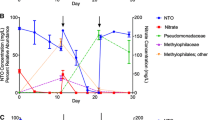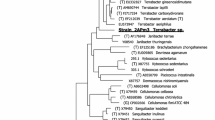Abstract
The methylotrophic bacteriumHyphomicrobium VS was enriched and isolated, using activated sewage sludge as inoculum in mineral medium containing dimethylsulfide (DMS) at a low concentration to prevent toxicity. DMS concentrations above 1 mM proved to be growth inhibiting.Hyphomicrobium VS could use DMS, dimethylsulfoxide (DMSO), methanol, formaldehyde, formate, and methylated amines as carbon and energy source. Carbon was assimilated via the serine pathway. DMS-grown cells respired sulfide, thiosulfate, methanethiol, dimethyldisulfide and dimethyltrisulfide.
To testHyphomicrobium VS for application in biofiltration of air polluted with volatile sulfur compounds two laboratory scale trickling biofilters with polyurethane and lava stone as carrier material were started up by inoculation with this bacterium. Both methanol- and DMS-grown cells could be used. Only a short adaptation period was needed. Short term experiments showed that high concentrations of DMS (1–2 µmol 1−1) were removed very efficiently by the biofilters at space velocities up to 100 h−1.
Similar content being viewed by others
Abbreviations
- VSC:
-
volatile sulfur compounds
- DMS:
-
dimethylsulfide
- DMDS:
-
dimethyldisulfide
- DMTS:
-
dimethyltrisulfide
- MT:
-
methanethiol
- DMSO:
-
dimethylsulfoxide
References
Blackmore MA & Quayle JR (1970) Microbial growth on oxalate by a route not involving glyoxylate carboligase. Biochem. J. 118: 53–59
Buisman CJN, Geraats BG, IJspeert P & Lettinga G (1990) Optimization of sulphur production in a biotechnological sulphide-removing reactor. Biotechnol. Bioeng. 35: 50–56
Charlson RJ, Lovelock JE, Andreae MO & Warren SG (1987) Oceanic phytoplankton sulphur, cloud albedo and climate. Nature 326: 655–661
Cho KS, Hirai M & Shoda M (1991a) Degradation characteristics of hydrogen sulfide, methanethiol, dimethyl sulfide and dimethyl disulfide byThiobacillus thioparus DW44 isolated from peat biofilter. J. Ferment. Bioeng. 71: 384–389
Cho KS, Hirai M & Shoda M (1992a) Enhanced removal efficiency of malodorous gases in a pilot-scale peat biofilter inoculated withThiobacillus thioparus DW44. J. Ferment. Bioeng. 73: 46–50
Cho KS, Hirai M & Shoda M (1992b) Enhanced removability of odorous sulfur-containing gases by mixed cultures of purified bacteria from peat biofilters. J. Ferment. Bioeng. 73: 219–224
Cho KS, Zhang L, Hirai M & Shoda M (1991b) Removal characteristics of hydrogen sulphide and methanethiol byThiobacillus sp. isolated from peat in biological deodorization. J. Ferment. Bioeng. 71: 44–49
De Bont JAM, Van Dijken JP & Harder W (1981) Dimethyl sulphoxide and dimethyl sulphide as a carbon, sulphur and energy source for growth ofHyphomicrobium S. J. Gen. Microbiol. 127: 315–323
Derikx PJL, Op den Camp HJM, Van der Drift C, Van Griensven LJLD & Vogels GD (1990) Odorous sulfur compounds emitted during production of compost used as a substrate in mushroom cultivation. Appl. Environ. Microbiol. 56: 176–180
Derikx PJL, Simons FHM, Op den Camp HJM, Van der Drift C, Van Griensven LJLD & Vogels GD (1991) Evolution of volatile sulfur compounds during laboratory-scale incubations and indoor preparation of compost used as a substrate in mushroom cultivation. Appl. Environ. Microbiol. 57: 563–567
Diks RMM (1992) The removal of dichloromethane from waste gases in a biological trickling filter. PhD Thesis. Technical University Eindhoven, The Netherlands
Duine JA, Frank J & Westerling J (1978) Purification and properties of methanol dehydrogenase fromHyphomicrobium X. Biochim. Biophys. Acta 524: 277–287
Harder W, Attwood MM & Quayle JR (1973) Methanol assimilation byHyphomicrobium sp. J. Gen. Microbiol. 78: 155–163
Harder W & Attwood MM (1978) Biology, physiology and biochemistry of hyphomicrobia. Adv. Microb. Physiol. 17: 303–359
Haywood GW & Large P (1981) Microbial oxidation of amines. Distribution, purification and properties of two primary amine oxidases from the yeastCandida boidinii grown on amines as sole nitrogen source. Biochem. J. 199: 187–201
Kanagawa T & Kelly DP ((1986) Breakdown of DMS by mixed cultures and byThiobacillus thioparus. FEMS Microbiol. Lett. 34: 13–19
Kelly DP & Smith NA (1990) Organic sulfur compounds in the environment. Biogeochemistry, microbiology and ecological aspects. Adv. Microb. Ecol. 11: 345–385
Kiene RP (1988) Dimethylsulfide metabolism in salt marsh sediments. FEMS Microbiol. Ecol 53: 71–78
Kirchner K, Hauk G & Rehm HJ (1987) Exhaust gas purification with immobilized monocultures (biocatalysts). Appl Microbiol. Biotechnol. 26: 579–587
Sasahira T, Matsui K & Arai T (1991) Removal of hydrogen sulfide byHyphomicrobiumneptunium ATCC 15444. Chem. Pharm. Bull. 39: 2990–2993
Sasahira T, Matsui K & Arai T (1992) Analysis of sulfur compounds produced with hydrogen sulfide byHyphomicrobium neptunium ATCC 15444. Chem. Pharm. Bull. 40: 799–801
Shoda M (1991) Methods for the biological treatment of exhaust gases. In: Martin AM (Ed) Biological Degradation of Wastes (pp 31–46). Elsevier Science Publishers, London
Suylen GMH (1988) Microbial metabolism of dimethyl sulphide and related compounds. PhD Thesis, Technical University Delft, The Netherlands
Suylen GMH & Kuenen JG (1986) Chemostat enrichment and isolation ofHyphomicrobium EG, a dimethyl-sulphide oxidizing methylotroph and reevaluation ofThiobacillus MS1. Antonie van Leeuwenhoek 52: 281–293
Suylen GMH, Stefess GC & Kuenen JG (1986) Chemolithotrophic potential of aHyphomicrobium species, capable of growth on methylated sulphur compounds. Arch. Microbiol. 146: 192–198
Tanji Y, Kanagawa T & Mikami E (1989) Removal of dimethyl sulfide, methyl mercaptan, and hydrogen sulfide by immobilizedThiobacillus thioparus TK-m. J. Ferment. Bioeng. 67: 280–285
Teunissen MJ, Marras SAE, Op den Camp HJM & Vogels GD (1989) Improved method for simultaneous determination of alcohols, volatile fatty acids, lactic acid or 2,3-butanediol in biological samples. J. Microbiol. Meth. 10: 247–254
Tiwaree RS, Cho KS, Hirai M & Shoda M (1992) Biological deodorization of dimethyl sulfide using different fabrics as the carriers of microorganisms. Appl. Biochem. Biotechnol. 32: 135–148
Van Alebeek GJWM, Hermans JMH, Keltjens JT, Vogels GD (1992) Quantification of intermediates involved in the cyclic 2,3-diphosphoglycerate metabolism of methanogenic bacteria by ionexchange chromatography. J. Chromatogr. 606: 65–71
Zhang L, Hirai M & Shoda M (1991) Removal characteristics of dimethyl sulfide, methanethiol and hydrogen sulfide byHyphomicrobium sp. 155 isolated from peat biofilter. J. Ferment. Bioeng. 72: 392–396
Author information
Authors and Affiliations
Rights and permissions
About this article
Cite this article
Pol, A., Op den Camp, H.J.M., Mees, S.G.M. et al. Isolation of a dimethylsulfide-utilizingHyphomicrobium species and its application in biofiltration of polluted air. Biodegradation 5, 105–112 (1994). https://doi.org/10.1007/BF00700635
Received:
Issue Date:
DOI: https://doi.org/10.1007/BF00700635




